TOYOTA AURIS 2012 (in English) Workshop Manual
Manufacturer: TOYOTA, Model Year: 2012, Model line: AURIS, Model: TOYOTA AURIS 2012Pages: 750, PDF Size: 20.05 MB
Page 51 of 750
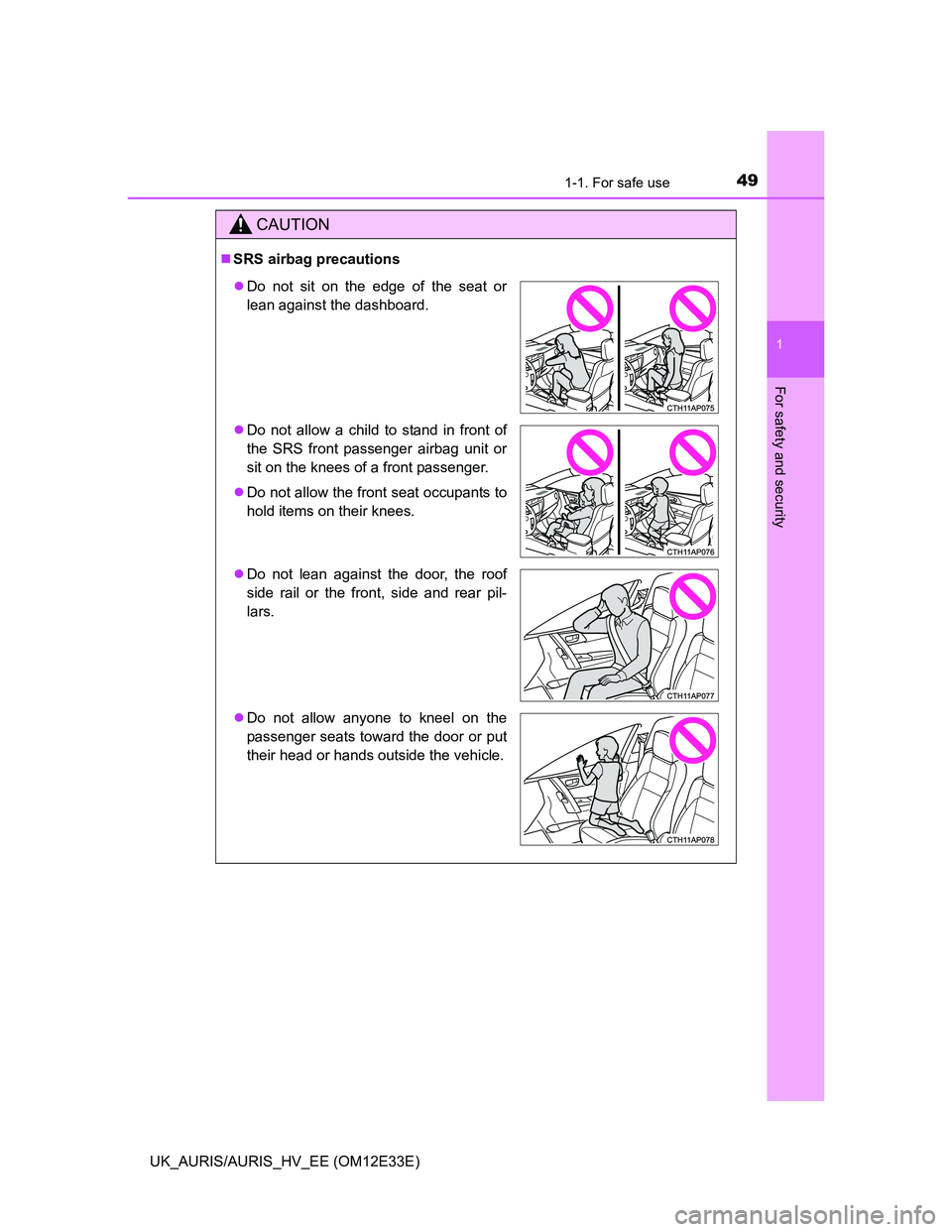
491-1. For safe use
1
For safety and security
UK_AURIS/AURIS_HV_EE (OM12E33E)
CAUTION
SRS airbag precautions
Do not sit on the edge of the seat or
lean against the dashboard.
Do not allow a child to stand in front of
the SRS front passenger airbag unit or
sit on the knees of a front passenger.
Do not allow the front seat occupants to
hold items on their knees.
Do not lean against the door, the roof
side rail or the front, side and rear pil-
lars.
Do not allow anyone to kneel on the
passenger seats toward the door or put
their head or hands outside the vehicle.
Page 52 of 750
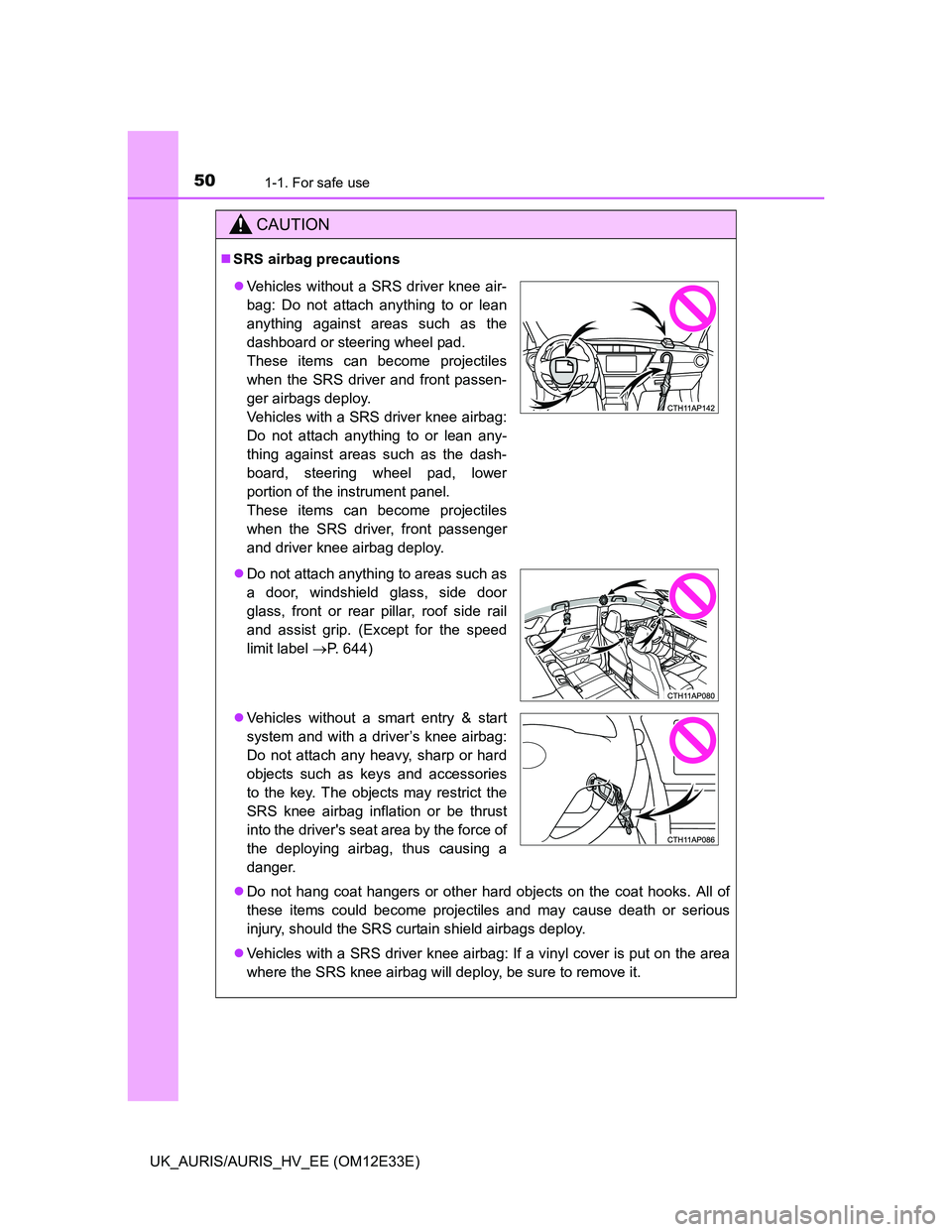
501-1. For safe use
UK_AURIS/AURIS_HV_EE (OM12E33E)
CAUTION
SRS airbag precautions
Do not hang coat hangers or other hard objects on the coat hooks. All of
these items could become projectiles and may cause death or serious
injury, should the SRS curtain shield airbags deploy.
Vehicles with a SRS driver knee airbag: If a vinyl cover is put on the area
where the SRS knee airbag will deploy, be sure to remove it.
Vehicles without a SRS driver knee air-
bag: Do not attach anything to or lean
anything against areas such as the
dashboard or steering wheel pad.
These items can become projectiles
when the SRS driver and front passen-
ger airbags deploy.
Vehicles with a SRS driver knee airbag:
Do not attach anything to or lean any-
thing against areas such as the dash-
board, steering wheel pad, lower
portion of the instrument panel.
These items can become projectiles
when the SRS driver, front passenger
and driver knee airbag deploy.
Do not attach anything to areas such as
a door, windshield glass, side door
glass, front or rear pillar, roof side rail
and assist grip. (Except for the speed
limit label P. 6 4 4 )
Vehicles without a smart entry & start
system and with a driver’s knee airbag:
Do not attach any heavy, sharp or hard
objects such as keys and accessories
to the key. The objects may restrict the
SRS knee airbag inflation or be thrust
into the driver's seat area by the force of
the deploying airbag, thus causing a
danger.
Page 53 of 750
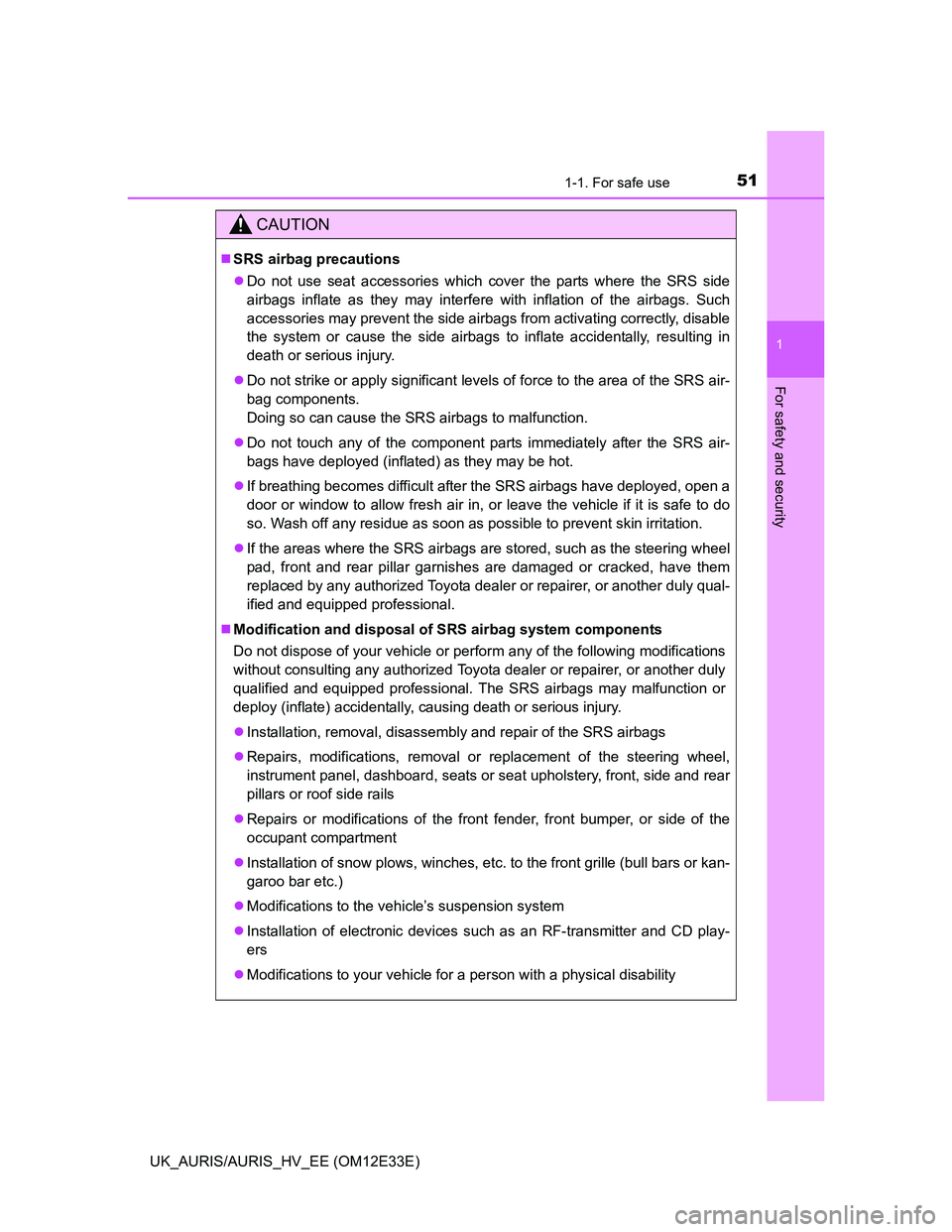
511-1. For safe use
1
For safety and security
UK_AURIS/AURIS_HV_EE (OM12E33E)
CAUTION
SRS airbag precautions
Do not use seat accessories which cover the parts where the SRS side
airbags inflate as they may interfere with inflation of the airbags. Such
accessories may prevent the side airbags from activating correctly, disable
the system or cause the side airbags to inflate accidentally, resulting in
death or serious injury.
Do not strike or apply significant levels of force to the area of the SRS air-
bag components.
Doing so can cause the SRS airbags to malfunction.
Do not touch any of the component parts immediately after the SRS air-
bags have deployed (inflated) as they may be hot.
If breathing becomes difficult after the SRS airbags have deployed, open a
door or window to allow fresh air in, or leave the vehicle if it is safe to do
so. Wash off any residue as soon as possible to prevent skin irritation.
If the areas where the SRS airbags are stored, such as the steering wheel
pad, front and rear pillar garnishes are damaged or cracked, have them
replaced by any authorized Toyota dealer or repairer, or another duly qual-
ified and equipped professional.
Modification and disposal of SRS airbag system components
Do not dispose of your vehicle or perform any of the following modifications
without consulting any authorized Toyota dealer or repairer, or another duly
qualified and equipped professional. The SRS airbags may malfunction or
deploy (inflate) accidentally, causing death or serious injury.
Installation, removal, disassembly and repair of the SRS airbags
Repairs, modifications, removal or replacement of the steering wheel,
instrument panel, dashboard, seats or seat upholstery, front, side and rear
pillars or roof side rails
Repairs or modifications of the front fender, front bumper, or side of the
occupant compartment
Installation of snow plows, winches, etc. to the front grille (bull bars or kan-
garoo bar etc.)
Modifications to the vehicle’s suspension system
Installation of electronic devices such as an RF-transmitter and CD play-
ers
Modifications to your vehicle for a person with a physical disability
Page 54 of 750
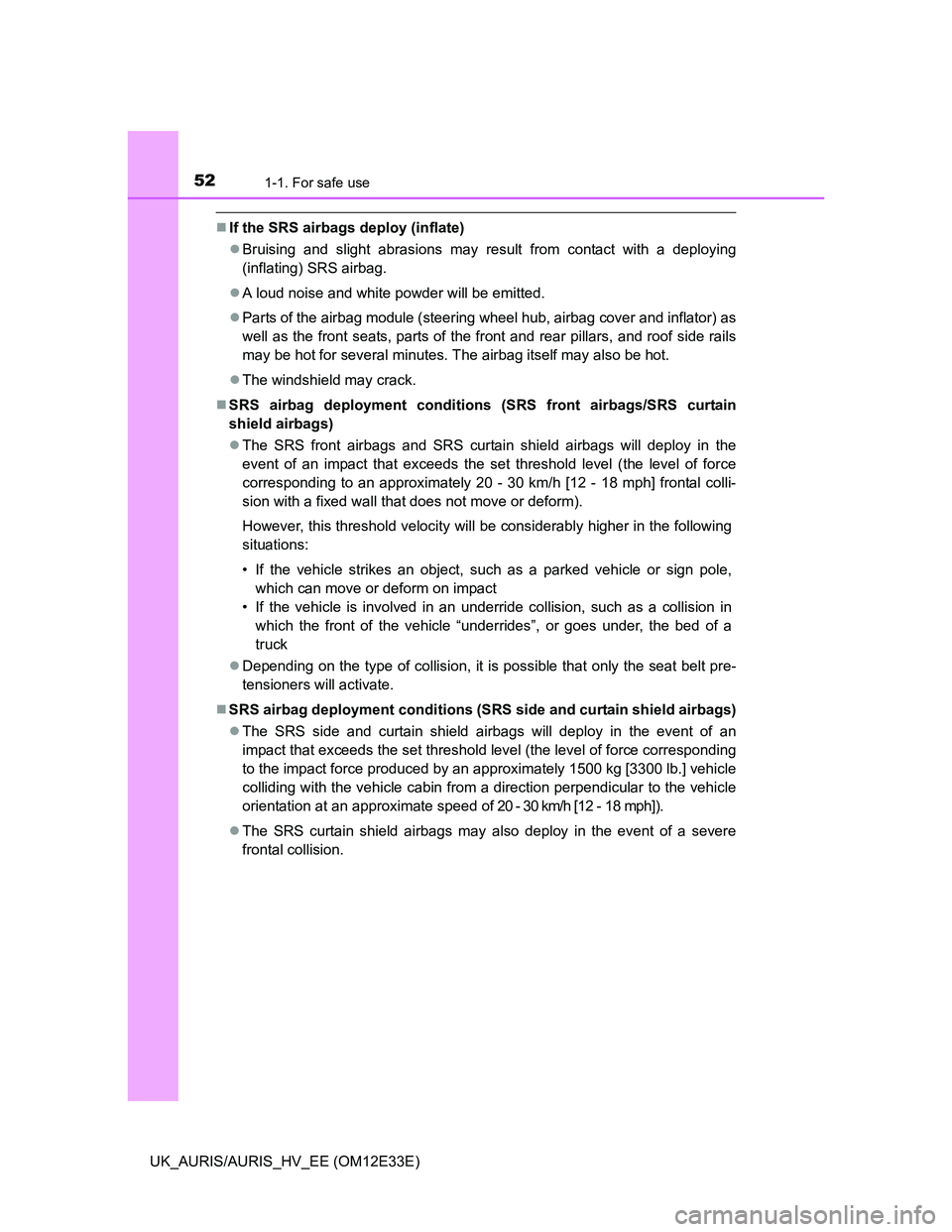
521-1. For safe use
UK_AURIS/AURIS_HV_EE (OM12E33E)
If the SRS airbags deploy (inflate)
Bruising and slight abrasions may result from contact with a deploying
(inflating) SRS airbag.
A loud noise and white powder will be emitted.
Parts of the airbag module (steering wheel hub, airbag cover and inflator) as
well as the front seats, parts of the front and rear pillars, and roof side rails
may be hot for several minutes. The airbag itself may also be hot.
The windshield may crack.
SRS airbag deployment conditions (SRS front airbags/SRS curtain
shield airbags)
The SRS front airbags and SRS curtain shield airbags will deploy in the
event of an impact that exceeds the set threshold level (the level of force
corresponding to an approximately 20 - 30 km/h [12 - 18 mph] frontal colli-
sion with a fixed wall that does not move or deform).
However, this threshold velocity will be considerably higher in the following
situations:
• If the vehicle strikes an object, such as a parked vehicle or sign pole,
which can move or deform on impact
• If the vehicle is involved in an underride collision, such as a collision in
which the front of the vehicle “underrides”, or goes under, the bed of a
truck
Depending on the type of collision, it is possible that only the seat belt pre-
tensioners will activate.
SRS airbag deployment conditions (SRS side and curtain shield airbags)
The SRS side and curtain shield airbags will deploy in the event of an
impact that exceeds the set threshold level (the level of force corresponding
to the impact force produced by an approximately 1500 kg [3300 lb.] vehicle
colliding with the vehicle cabin from a direction perpendicular to the vehicle
orientation at an approximate speed of 20 - 30 km/h [12 - 18 mph]).
The SRS curtain shield airbags may also deploy in the event of a severe
frontal collision.
Page 55 of 750
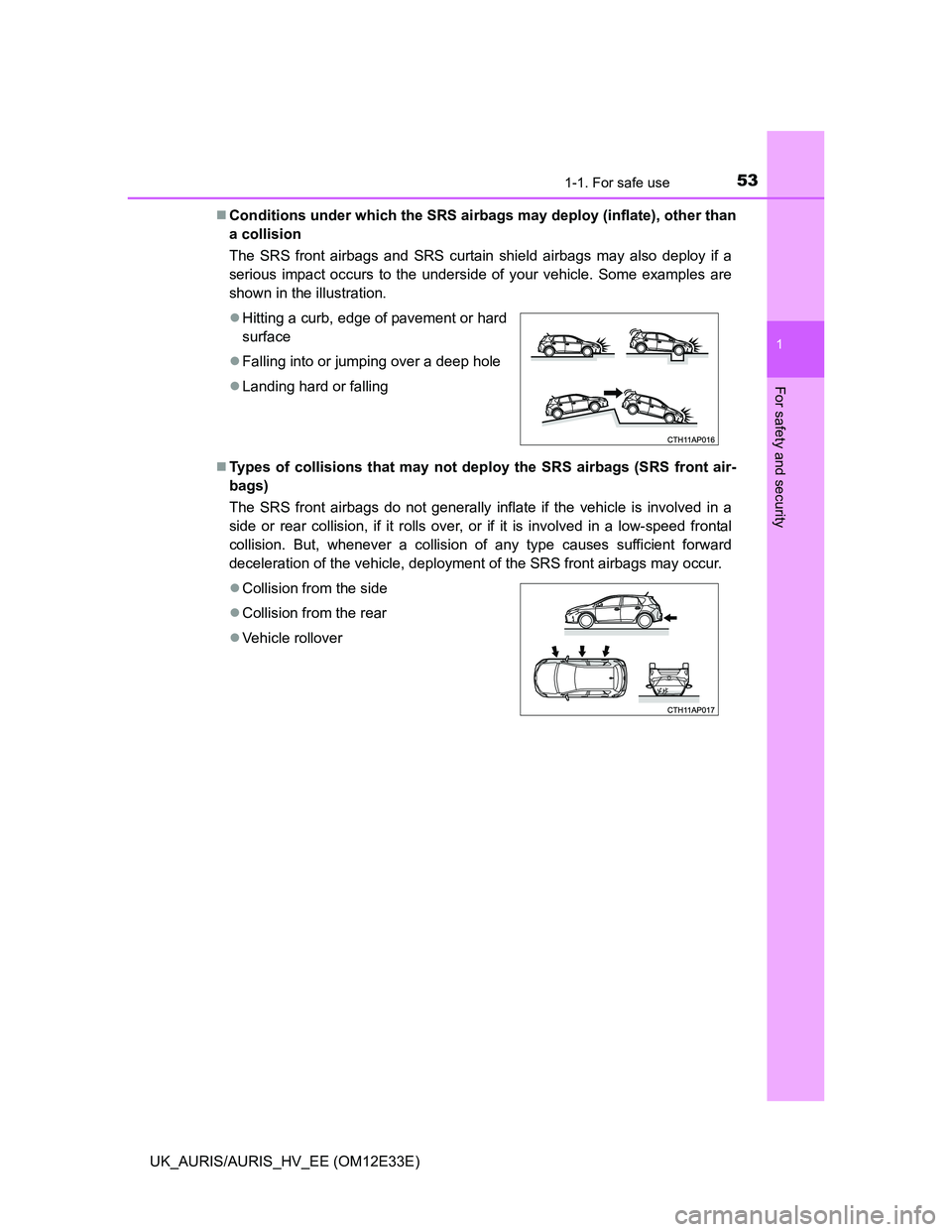
531-1. For safe use
1
For safety and security
UK_AURIS/AURIS_HV_EE (OM12E33E)Conditions under which the SRS airbags may deploy (inflate), other than
a collision
The SRS front airbags and SRS curtain shield airbags may also deploy if a
serious impact occurs to the underside of your vehicle. Some examples are
shown in the illustration.
Types of collisions that may not deploy the SRS airbags (SRS front air-
bags)
The SRS front airbags do not generally inflate if the vehicle is involved in a
side or rear collision, if it rolls over, or if it is involved in a low-speed frontal
collision. But, whenever a collision of any type causes sufficient forward
deceleration of the vehicle, deployment of the SRS front airbags may occur. Hitting a curb, edge of pavement or hard
surface
Falling into or jumping over a deep hole
Landing hard or falling
Collision from the side
Collision from the rear
Vehicle rollover
Page 56 of 750
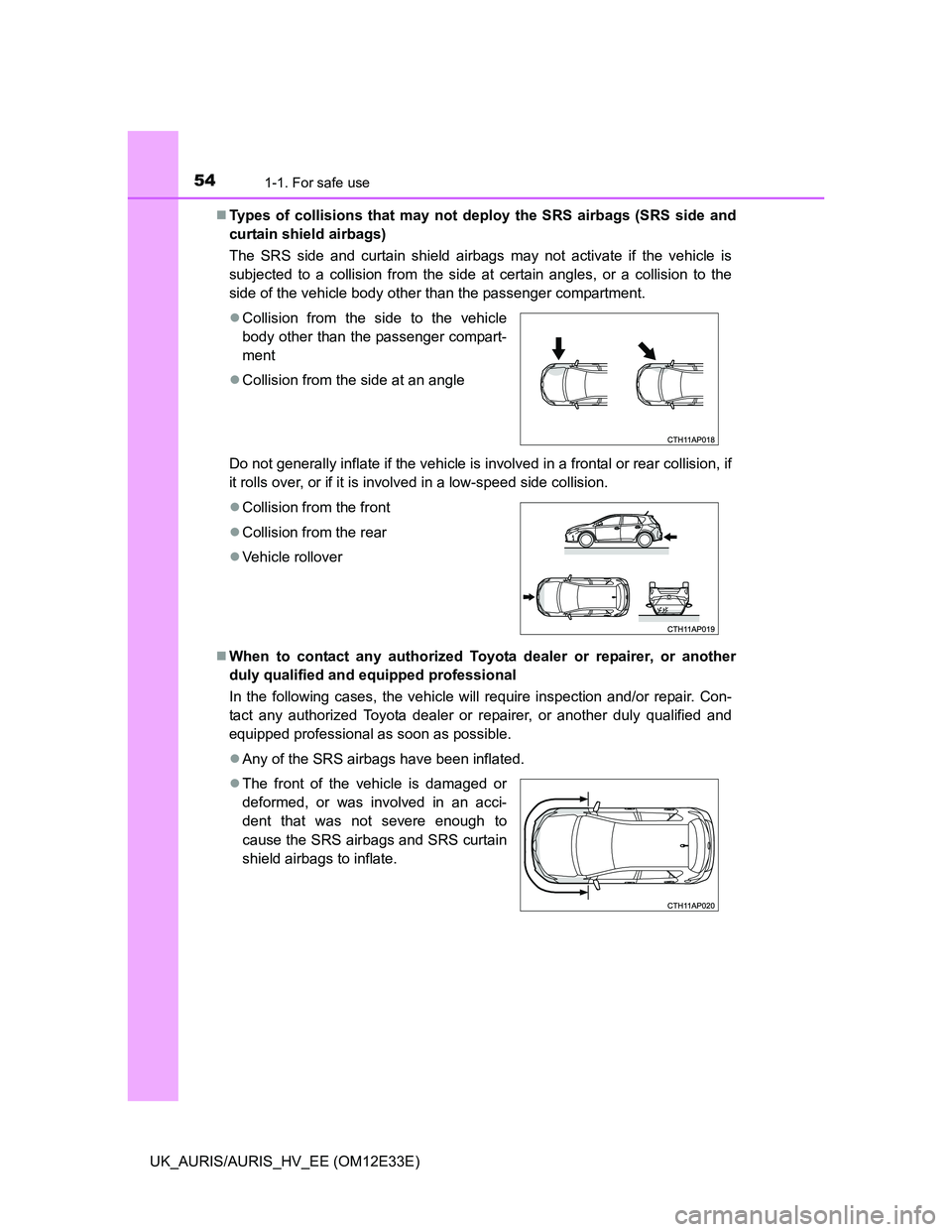
541-1. For safe use
UK_AURIS/AURIS_HV_EE (OM12E33E)Types of collisions that may not deploy the SRS airbags (SRS side and
curtain shield airbags)
The SRS side and curtain shield airbags may not activate if the vehicle is
subjected to a collision from the side at certain angles, or a collision to the
side of the vehicle body other than the passenger compartment.
Do not generally inflate if the vehicle is involved in a frontal or rear collision, if
it rolls over, or if it is involved in a low-speed side collision.
When to contact any authorized Toyota dealer or repairer, or another
duly qualified and equipped professional
In the following cases, the vehicle will require inspection and/or repair. Con-
tact any authorized Toyota dealer or repairer, or another duly qualified and
equipped professional as soon as possible.
Any of the SRS airbags have been inflated. Collision from the side to the vehicle
body other than the passenger compart-
ment
Collision from the side at an angle
Collision from the front
Collision from the rear
Vehicle rollover
The front of the vehicle is damaged or
deformed, or was involved in an acci-
dent that was not severe enough to
cause the SRS airbags and SRS curtain
shield airbags to inflate.
Page 57 of 750
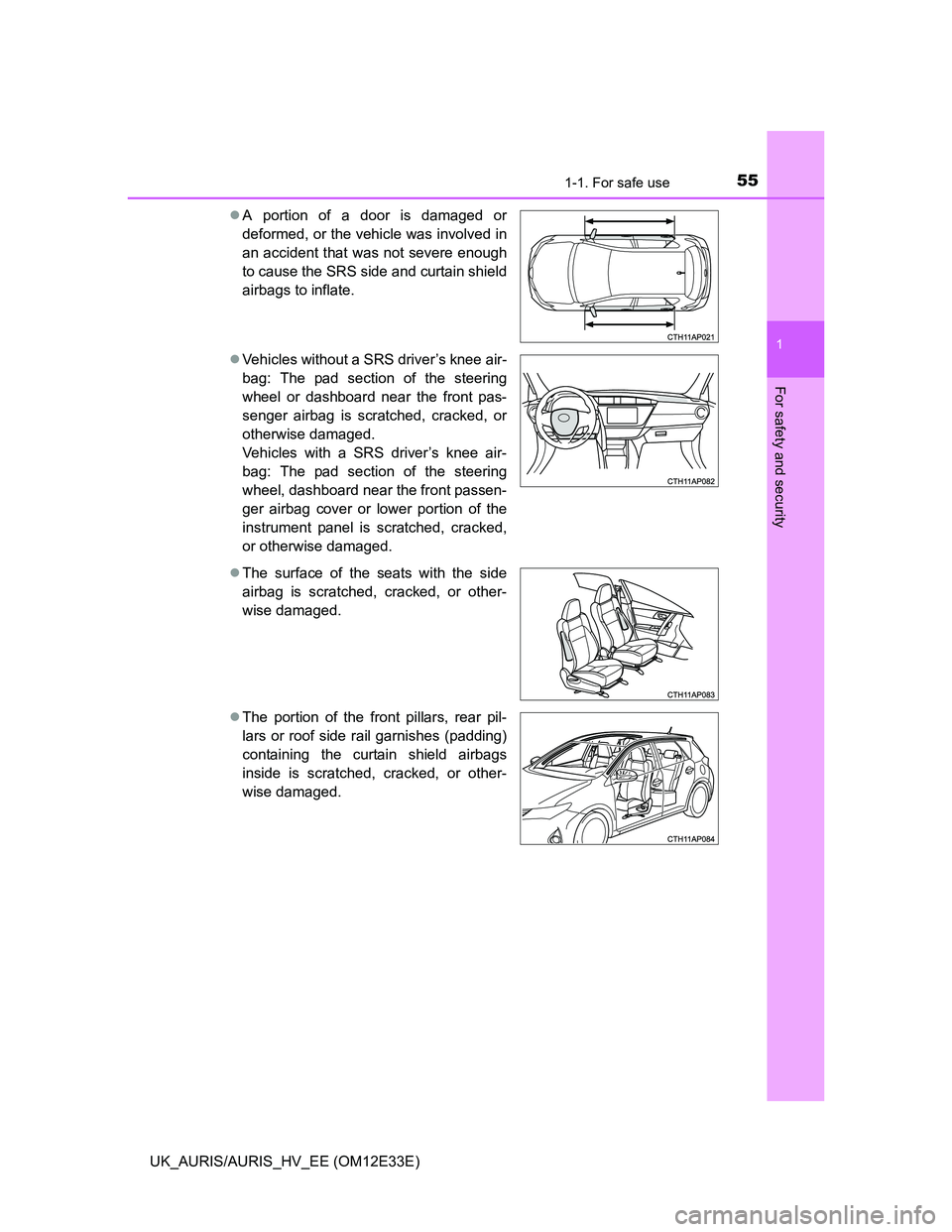
551-1. For safe use
1
For safety and security
UK_AURIS/AURIS_HV_EE (OM12E33E)A portion of a door is damaged or
deformed, or the vehicle was involved in
an accident that was not severe enough
to cause the SRS side and curtain shield
airbags to inflate.
Vehicles without a SRS driver’s knee air-
bag: The pad section of the steering
wheel or dashboard near the front pas-
senger airbag is scratched, cracked, or
otherwise damaged.
Vehicles with a SRS driver’s knee air-
bag: The pad section of the steering
wheel, dashboard near the front passen-
ger airbag cover or lower portion of the
instrument panel is scratched, cracked,
or otherwise damaged.
The surface of the seats with the side
airbag is scratched, cracked, or other-
wise damaged.
The portion of the front pillars, rear pil-
lars or roof side rail garnishes (padding)
containing the curtain shield airbags
inside is scratched, cracked, or other-
wise damaged.
Page 58 of 750
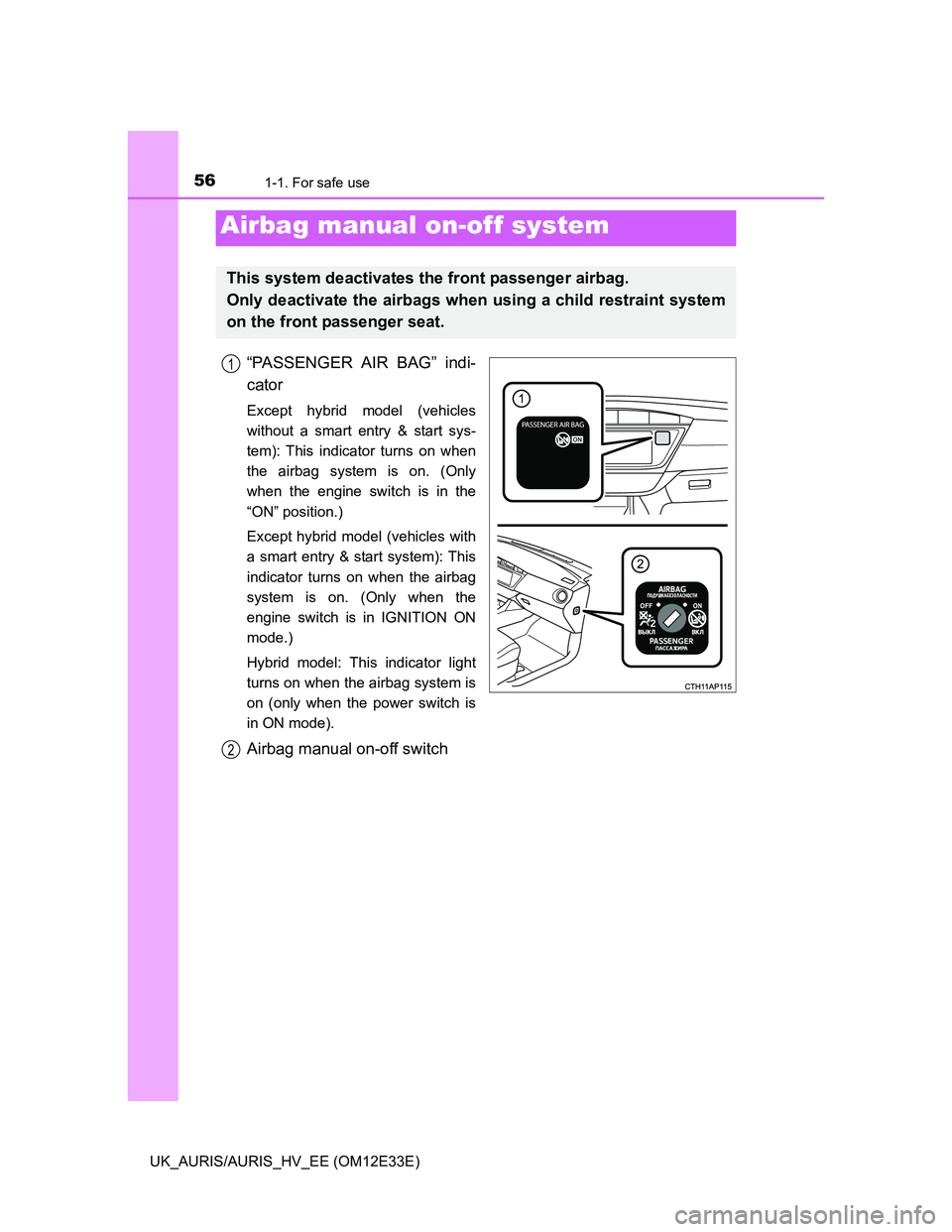
561-1. For safe use
UK_AURIS/AURIS_HV_EE (OM12E33E)
“PASSENGER AIR BAG” indi-
cator
Except hybrid model (vehicles
without a smart entry & start sys-
tem): This indicator turns on when
the airbag system is on. (Only
when the engine switch is in the
“ON” position.)
Except hybrid model (vehicles with
a smart entry & start system): This
indicator turns on when the airbag
system is on. (Only when the
engine switch is in IGNITION ON
mode.)
Hybrid model: This indicator light
turns on when the airbag system is
on (only when the power switch is
in ON mode).
Airbag manual on-off switch
Airbag manual on-off system
This system deactivates the front passenger airbag.
Only deactivate the airbags when using a child restraint system
on the front passenger seat.
1
2
Page 59 of 750
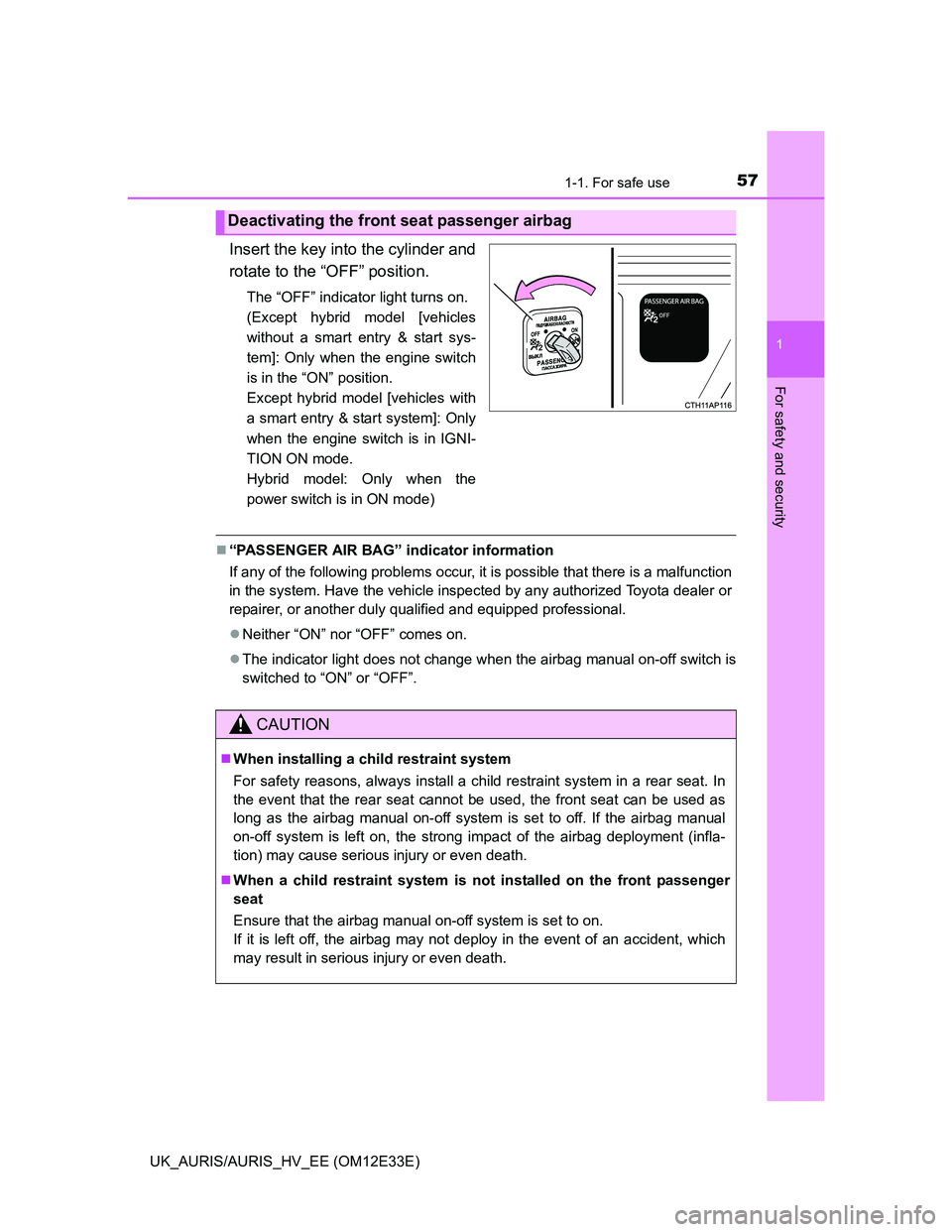
571-1. For safe use
1
For safety and security
UK_AURIS/AURIS_HV_EE (OM12E33E)
Insert the key into the cylinder and
rotate to the “OFF” position.
The “OFF” indicator light turns on.
(Except hybrid model [vehicles
without a smart entry & start sys-
tem]: Only when the engine switch
is in the “ON” position.
Except hybrid model [vehicles with
a smart entry & start system]: Only
when the engine switch is in IGNI-
TION ON mode.
Hybrid model: Only when the
power switch is in ON mode)
“PASSENGER AIR BAG” indicator information
If any of the following problems occur, it is possible that there is a malfunction
in the system. Have the vehicle inspected by any authorized Toyota dealer or
repairer, or another duly qualified and equipped professional.
Neither “ON” nor “OFF” comes on.
The indicator light does not change when the airbag manual on-off switch is
switched to “ON” or “OFF”.
Deactivating the front seat passenger airbag
CAUTION
When installing a child restraint system
For safety reasons, always install a child restraint system in a rear seat. In
the event that the rear seat cannot be used, the front seat can be used as
long as the airbag manual on-off system is set to off. If the airbag manual
on-off system is left on, the strong impact of the airbag deployment (infla-
tion) may cause serious injury or even death.
When a child restraint system is not installed on the front passenger
seat
Ensure that the airbag manual on-off system is set to on.
If it is left off, the airbag may not deploy in the event of an accident, which
may result in serious injury or even death.
Page 60 of 750
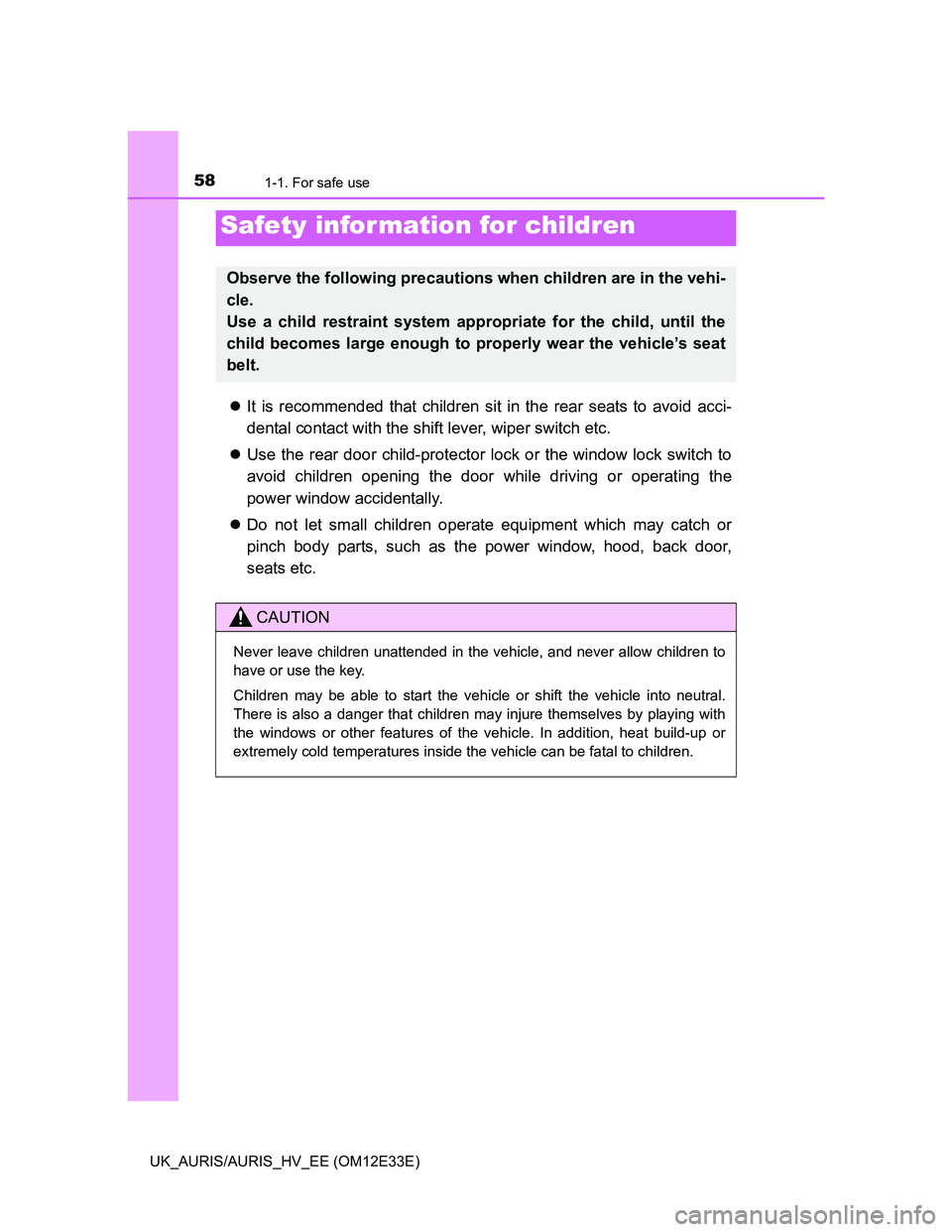
581-1. For safe use
UK_AURIS/AURIS_HV_EE (OM12E33E)
It is recommended that children sit in the rear seats to avoid acci-
dental contact with the shift lever, wiper switch etc.
Use the rear door child-protector lock or the window lock switch to
avoid children opening the door while driving or operating the
power window accidentally.
Do not let small children operate equipment which may catch or
pinch body parts, such as the power window, hood, back door,
seats etc.
Safety infor mation for children
Observe the following precautions when children are in the vehi-
cle.
Use a child restraint system appropriate for the child, until the
child becomes large enough to properly wear the vehicle’s seat
belt.
CAUTION
Never leave children unattended in the vehicle, and never allow children to
have or use the key.
Children may be able to start the vehicle or shift the vehicle into neutral.
There is also a danger that children may injure themselves by playing with
the windows or other features of the vehicle. In addition, heat build-up or
extremely cold temperatures inside the vehicle can be fatal to children.